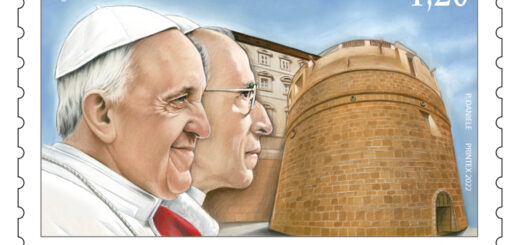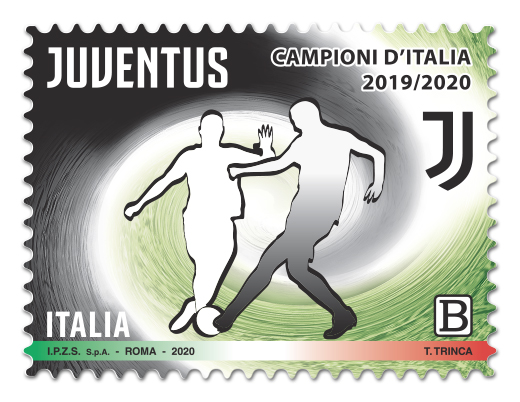POSTE ITALIANE 44^ emissione del 24 Settembre 2020 di un francobollo dedicato a F.lli Gancia & C. S.p.A, nel 170° anniversario di attività
POSTE ITALIANE 44^ emissione del 24 Settembre 2020 di un francobollo dedicato a F.lli Gancia & C. S.p.A, nel 170° anniversario di attività
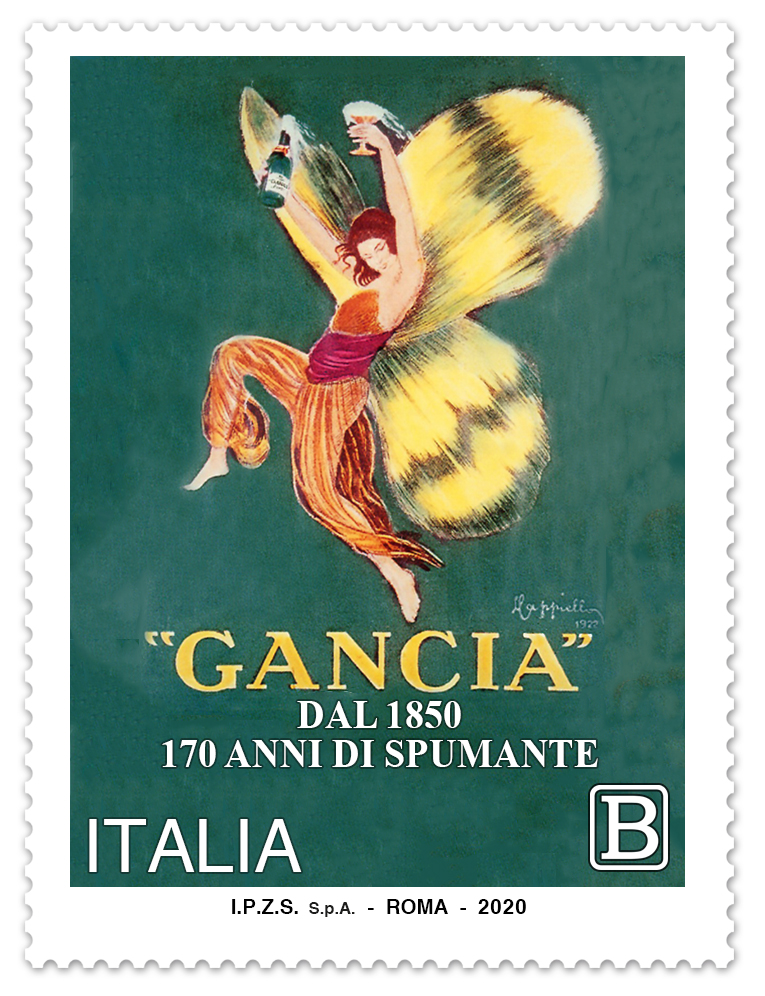
Il Ministero dello Sviluppo con le Poste Italiane emette il 24 settembre 2020 un francobollo ordinario appartenente alla serie tematica “le Eccellenze del sistema produttivo ed economico” dedicato a F.lli Gancia & C. nel 170° anniversario di attività, relativo al valore della tariffa B, corrispondente ad € 1.10.
- data: 24 settembre 2020
- dentellatura: 11
- stampa: rotocalcografia
- tipo di carta; carta bianca patinata neutra -autoadesiva non fluorescente
- stampato: I.P.Z.S. Roma
- tiratura: 400.000
- dimensioni: 30 x 40 mm
- contenuto foglio: 45 esemplari
- valore: B = €1.10
- bozzettista: a cura della F.lli. Gancia & C. S.p.A. e ottimizzato dal Centro Filatelico della Direzione Operativa dell’Istituto Poligrafico e Zecca dello Stato S.p.A.
- num. catalogo: Michel ______ YT _______ UNIF _4069___
- La vignetta: riproduce, un manifesto d’epoca della F.lli. Gancia & C. S.p.A del 1922 denominato “Donna Farfalla” realizzato dall’illustratore e pittore Leonetto Cappiello. Completano il francobollo le leggende “GANCIA” e “DAL 1850 170 ANNI DI SPUMANTE”, la scritta “ITALIA” e l’indicazione tariffaria “B”.
Se sei interessato all’acquisto di questo francobollo lo puoi acquistare al prezzo di € 1.50. Inviandomi una richiesta alla email: protofilia1@gmail.com
La Gancia è una delle più importanti case vitivinicole italiane, con sede a Canelli, in Piemonte, rinomata in tutto il mondo nella specializzazione dei vini spumante.
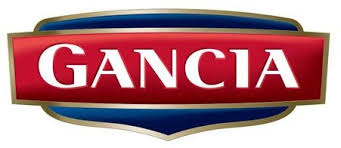
Storia
La fondazione
Il nome lo si deve al fondatore Carlo Gancia, nato nel 1829 a Narzole, in Provincia di Cuneo, Piemonte, settimo figlio di Caterina Rosso e Michele Gancia, quest’ultimo erede di numerosi poderi e terreni agricoli nella zona di Canelli, in (Provincia di Asti), tanto da iniziarvi una prospera viticoltura, in special modo di uve di moscato.
Il piccolo Carlo resta affascinato di come le sapienti mani del padre riescano a trasformare i grappoli d’uva in vino, tanto da farne una passione. Appena quindicenne quindi, nel 1845 si trasferisce stabilmente a Torino, dove studia per poi entrare all’Università degli Studi delle facoltà di chimica e farmacia. Agli studi, affianca esperienze da tirocinante negli allora laboratori chimici di confettieri ed acquavitai torinesi compiendo, insieme a loro, vari esperimenti enologici.
A soli 18 anni, Carlo Gancia diventa dapprima socio, poi direttore della antica caffetteria-liquoreria torinese di Piazza Castello, la Dettoni e C., sperimentando e brevettando una nuova ricetta per il vermouth, basata sull’utilizzo di uve moscato come base per ammorbidire l’infuso, ottenendo così un prodotto innovativo e dal vasto successo.
Non ancora soddisfatto, l’anno dopo il giovane Carlo decide di recarsi in Francia, per studiare la spumantizzazione dello champagne. Dal 1849 vive stabilmente a Reims, nel Grand Est, patria del vino spumante champagne, dove entra, come semplice operaio, alla rinomata ditta di vini Piper-Heidsieck. Qui vi rimane per un paio d’anni, dove diventa addetto esperto alla vinificazione, e dove apprende il metodo champenoise per la spumantizzazione, quindi importato in Italia col nome di “metodo classico”. A tale metodo, Carlo Gancia applicherà soltanto alcune semplificazioni della procedura, al fine di velocizzare i tempi e abbassare i costi di produzione massiva delle bottiglie.
Il primo spumante italiano
Mentre i vini di uve moscato e i relativi laboratori di vermouth riscuotono successo a Canelli, in tutto il Piemonte ed oltre (molto mercato era diretto anche in Francia) già dalla prima metà del XIX secolo, nel 1850 Carlo Gancia torna in Piemonte, affitta una cantina a Chivasso, a circa 20 km nord da Torino, e coinvolge suo fratello Edoardo in esperimenti di spumantizzazione col metodo champenoise appena appreso in Francia. Carlo capisce subito il bisogno di impiantare nuove vigne di moscato e, con l’appena nominato socio Arnaldo Strucchi, quest’ultimo già direttore dell’azienda Cora di Costigliole d’Asti, studia nuove aree idonee in loco. Trovano consenso anche da Camillo Benso, conte di Cavour, ma la legge in favore dell’ampliamento delle zone di coltura destinate a differenti tipi di uva non viene modificata.
Nel frattempo, la cantina di Chivasso diventa presto una vera e propria fabbrica che, nel 1851, si chiamerà semplicemente Fratelli Gancia. La cittadina di Chivasso è vicina a Torino, unico nodo ferroviario utile per allargare la produzione e, nel 1861, grazie anche all’Unità d’Italia, la ditta siglerà degli accordi con la Società per le Ferrovie dell’Alta Italia. Tuttavia, la sperimentazione della spumantizzazione attraverso il cosiddetto “metodo classico” avverrà soltanto quattro anni dopo, quando, togliendo gli sciroppi richiesti dalla lavorazione francese, Carlo Gancia presenterà il suo primo “Spumante italiano”, iniziando l’esportazione estera già l’anno dopo. A lui si deve la brillante intuizione dell’interruzione della fermentazione con ripetuta filtrazione del mosto, al fine di ottenere uno spumante di tipo demi-sec (zuccheri 35-40 g/l) unito ad una bassa gradazione alcolica, e all’epoca chiamato anche moscato champagne.
La sede di Canelli (Asti)
Per ottimizzare tempi e produzione , nel 1865 diventa ormai doveroso spostare l’azienda del neonato “Spumante italiano” da Chivasso a Canelli, dove viene eretta la storica sede di Corso Libertà. Nel frattempo, Carlo Gancia manda il famoso enologo Giovanni Gallese di nuovo in Francia, per studiare ulteriormente i processi del metodo classico. Il perfezionamento dà i suoi frutti negli anni immediatamente successivi, quando Gancia diventa un marchio famoso in tutta Europa, tanto da ricevere un diploma all’Esposizione Universale di Vienna del 1873 e un premio a quella di Parigi nel 1878. Sempre nello stesso periodo, Carlo Gancia si sposa con Marietta Barbero (1870), che gli dà cinque figli: Adelina, Camillo, Giuseppina, Carlo Edoardo e Gaspare Giacomo. L’azienda acquista sempre più notorietà anche oltre i confini europei, tanto che, all’azienda si aggiungono altri soci e, nel 1880, si costituirà l’azienda “Fratelli Gancia & C.”. Nel 1897 muore Carlo Gancia e l’azienda passa al primogenito maschio Camillo.
Epoca recente
All’inizio del XX secolo continua una buona prosperità per l’azienda, tanto da espandere ulteriormente i vigneti, le cantine e la produzione. Tuttavia, nel 1916, un’epidemia di fillossera costringe l’estirpazione di molte piante, col impianto di vitigni di moscato a base americana. Nel 1920, nasce il Gancia Bianco, ovvero il primo vermouth bianco italiano. Nel 1924, l’azienda diventa fornitore ufficiale dei Sacri palazzi Apostolici mentre, nel 1937, fornitore (“provveditore”) della Real Casa Savoia.
Nel 1950, proprio grazie al vermouth rosso Gancia, nasce il cosiddetto cocktail “bitter americano”. Poco dopo inizierà la produzione del noto Asti spumante, che otterrà la D.O.C. nel 1967 e la D.O.C.G. nel 1993.
Nel 1994, l’azienda passa a suo figlio sessantenne Vittorio Vallarino Gancia il quale, nello stesso anno viene nominato Cavaliere del Lavoro. Vittorio Gancia ha due figli, Massimiliano e Lamberto, già con posizioni di dirigenza in azienda. I fratelli Massimiliano e Lamberto Vallarino Gancia continueranno a gestire l’azienda, proponendo sempre delle innovazioni. Nel 1998 ad esempio, Massimiliano promuove l’edizione dello spumante Asti Castello Gancia. Nel contesto vitivinicolo di Canelli, verranno istituite rassegne e iniziative dedicate allo spumante, come la tradizionale ed estiva Festa dei Conferenti Gancia, ma anche Cantine aperte e Vincanta. Sia a Canelli, che in alcune zone limitrofe, la produzione di vini spumanti ha una ricca e secolare tradizione, che risiede anche nelle vicine aziende Cinzano, Riccadonna, Bosca, Coppo, Cora e Tosti e, tuttavia, sempre con uno spirito di una sana competizione sul mercato, unita ad una reciproca collaborazione della promozione turistica ed enogastronomica dell’intero territorio. In particolare, Lamberto Vallarino Gancia si occuperà di immagine e marketing aziendale, promuovendo le fiere espositive, ad esempio diventando consigliere per le Politiche Agricole durante l’Expo Universale di Milano 2015 e, poco dopo, direttore del Teatro Stabile di Torino.
Nel 2010, inizia un graduale processo di acquisizione dei pacchetti azionari dell’azienda da parte del magnate russo Rustam Tariko, noto ai mercati come il “re della vodka” Russian Standard; pur lasciando il marchio Gancia, la produzione a Canelli e le uve sempre italiane, l’azienda diventerà proprietà della Russian Standard al 95%, alla fine del luglio 2013. Verranno nominati, come amministratori delegati, dapprima Paolo Fontana, poi Sergio Fava lista delle Cantine Storiche dell’Asti spumante e diventa patrimonio dell’umanità, nel contesto del paesaggio vitivinicolo del Piemonte: Langhe-Roero e Monferrato, con codice 1390-010. Negli ultimi anni, vengono prodotti spumanti anche con delle uve Chardonnay, come il Brut 18 mesi, e uve Pinot Nero classico e Rosé. Dal 2018 è iniziata anche la produzione e la vendita dell’Asti spumante secco D.O.C.G..
POSTE ITALIANE 44th issue on 24 September 2020 of a stamp dedicated to F.lli Gancia & C. S.p.A, on the 170th anniversary of its activity
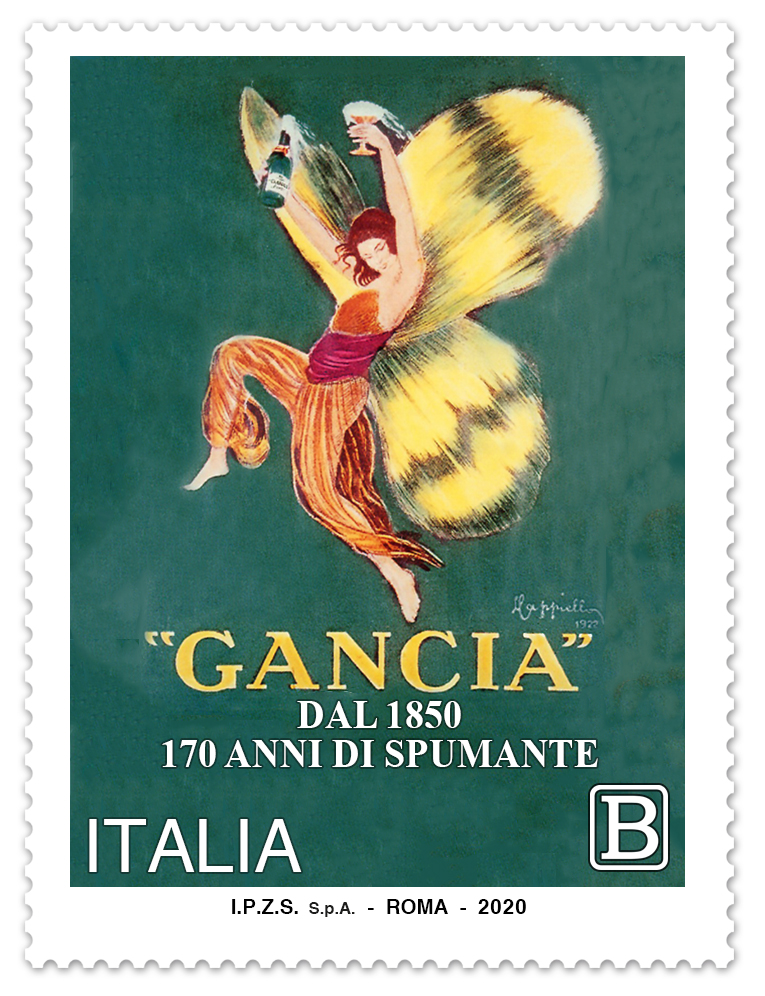
The Ministry of Development with the Italian Post Office issues on 24 September 2020 an ordinary stamp belonging to the thematic series “The Excellencies of the productive and economic system” dedicated to F.lli Gancia & C. on the 170th anniversary of activity, relating to the value of the tariff B, corresponding to € 1.10.
date: September 24, 2020
indentation: 11
printing: rotogravure
Type of paper; neutral white coated paper – self-adhesive non-fluorescent
printed: I.P.Z.S. Rome
circulation: 400,000
dimensions: 30 x 40 mm
sheet content: 45 copies
value: B = € 1.10
sketcher: edited by F.lli. Gancia & C. S.p.A. and optimized by the Philatelic Center of the Operational Department of the Polygraphic Institute and State Mint S.p.A.
num. catalog: Michel______ YT________ UNIF __________
The cartoon: reproduces a vintage poster by F.lli. Gancia & C. S.p.A of 1922 called “Donna Farfalla” created by the illustrator and painter Leonetto Cappiello. The stamp is completed by the legends “GANCIA” and “170 YEARS OF SPARKLING WINE SINCE 1850”, the wording “ITALIA” and the tariff indication “B”.
If you are interested in purchasing this stamp, you can buy it for € 1.50. By sending me a request to the email: protofilia1@gmail.com
La Gancia is one of the most important Italian wineries, based in Canelli, Piedmont, renowned throughout the world in the specialization of sparkling wines.

History
The foundation
The name is due to the founder Carlo Gancia, born in 1829 in Narzole, in the Province of Cuneo, Piedmont, seventh son of Caterina Rosso and Michele Gancia, the latter heir to numerous farms and agricultural land in the Canelli area, in (Provincia of Asti), so much so that a prosperous viticulture started there, especially of Muscat grapes.
Little Carlo is fascinated by how his father’s skilled hands are able to transform the bunches of grapes into wine, so much so as to make it a passion. So when he was barely fifteen, in 1845 he moved permanently to Turin, where he studied and then entered the University of Chemistry and Pharmacy. In addition to his studies, he combined experiences as a trainee in the then chemical laboratories of Turin’s confectioners and spirits making, together with them, various oenological experiments.
At the age of 18, Carlo Gancia first became a partner, then director of the ancient Turin cafeteria-liqueur shop in Piazza Castello, Dettoni e C., experimenting and patenting a new recipe for vermouth, based on the use of muscat grapes as a basis for softening the infusion, thus obtaining an innovative and highly successful product.
Not yet satisfied, the following year the young Carlo decided to go to France to study the sparkling wine making of champagne. Since 1849 he has lived permanently in Reims, in the Grand Est, home of champagne sparkling wine, where he joins, as a simple worker, the renowned Piper-Heidsieck wine company. Here he remained for a couple of years, where he became an expert in winemaking, and where he learned the champenoise method for sparkling wine, then imported into Italy with the name of “classic method”. To this method, Carlo Gancia will apply only some simplifications of the procedure, in order to speed up the times and lower the costs of mass production of the bottles.
The first Italian sparkling wine
While muscat grape wines and the related vermouth laboratories have been successful in Canelli, throughout Piedmont and beyond (a lot of the market was also directed to France) since the first half of the nineteenth century, in 1850 Carlo Gancia returned to Piedmont, rents a cellar in Chivasso, about 20 km north of Turin, and involves his brother Edoardo in sparkling experiments with the champenoise method he has just learned in France. Carlo immediately understood the need to plant new Muscat vineyards and, with the newly appointed partner Arnaldo Strucchi, the latter already director of the Cora company in Costigliole d’Asti, he studied new suitable areas on site. They also find consent from Camillo Benso, count of Cavour, but the law in favor of the expansion of the cultivation areas intended for different types of grapes is not changed.
In the meantime, the Chivasso cellar soon became a real factory which, in 1851, was simply called Fratelli Gancia. The town of Chivasso is close to Turin, the only railway junction useful for expanding production and, in 1861, thanks also to the unification of Italy, the company will sign agreements with the Società per le Ferrovie dell’Alta Italia. However, the experimentation of sparkling wine through the so-called “classic method” will take place only four years later, when, removing the syrups required by the French processing, Carlo Gancia will present his first “Italian Spumante”, starting export abroad already the following year. . We owe to him the brilliant intuition of the interruption of fermentation with repeated filtration of the must, in order to obtain a demi-sec type sparkling wine (sugars 35-40 g / l) combined with a low alcohol content, and at the time called also muscat champagne.
The headquarters in Canelli (Asti)
To optimize times and production, in 1865 it became a duty to move the company of the newborn “Spumante Italiano” from Chivasso to Canelli, where the historic headquarters in Corso Libertà were erected. Meanwhile, Carlo Gancia sends the famous winemaker Giovanni Gallese back to France, to further study the processes of the classical method. The improvement bears fruit in the years immediately following, when Gancia became a famous brand throughout Europe, so much so that he received a diploma at the Universal Exhibition in Vienna in 1873 and an award at that of Paris in 1878. Also in the same period, Carlo Gancia married Marietta Barbero (1870), who gave him five children: Adelina, Camillo, Giuseppina, Carlo Edoardo and Gaspare Giacomo. The company acquires more and more notoriety even beyond the European borders, so much so that other partners are added to the company and, in 1880, the company “Fratelli Gancia & C.” will be established. In 1897 Carlo Gancia died and the company passed to the first-born male Camillo.
Recent era
At the beginning of the twentieth century, good prosperity continued for the company, so much so that the vineyards were further expanded i, the cellars and production. However, in 1916, a phylloxera epidemic forced the eradication of many plants, with the planting of American-based Muscat vines. In 1920, Gancia Bianco, the first Italian white vermouth, was born. In 1924, the company became the official supplier of the Sacred Apostolic palaces while, in 1937, supplier (“administrator”) of the Royal House of Savoy.
In 1950, thanks to the Gancia red vermouth, the so-called “American bitter” cocktail was born. Shortly afterwards, the production of the well-known Asti spumante will begin, which will obtain the D.O.C. in 1967 and the D.O.C.G. in 1993.
In 1994, the company passed to his sixty-year-old son Vittorio Vallarino Gancia who, in the same year, was named Cavaliere del Lavoro. Vittorio Gancia has two sons, Massimiliano and Lamberto, who already hold management positions in the company. The brothers Massimiliano and Lamberto Vallarino Gancia will continue to manage the company, always proposing innovations. In 1998, for example, Massimiliano promoted the Asti Castello Gancia sparkling wine edition. In the wine-growing context of Canelli, reviews and initiatives dedicated to sparkling wine will be set up, such as the traditional and summer Festa dei Conferenti Gancia, but also Cantine Aperto and Vincanta. Both in Canelli and in some neighboring areas, the production of sparkling wines has a rich and centuries-old tradition, which also resides in the nearby companies Cinzano, Riccadonna, Bosca, Coppo, Cora and Tosti and, however, always with a spirit of healthy competition on the market, combined with a mutual collaboration of the tourism and food and wine promotion of the entire territory. In particular, Lamberto Vallarino Gancia will deal with corporate image and marketing, promoting exhibition fairs, for example by becoming an advisor for Agricultural Policies during the 2015 Milan Universal Expo and, shortly after, director of the Teatro Stabile di Torino.
In 2010, a gradual process of acquiring the company’s shares began by the Russian tycoon Rustam Tariko, known to the markets as the “king of vodka” Russian Standard; while leaving the Gancia brand, production in Canelli and the Italian grapes, the company will become 95% owned by the Russian Standard at the end of July 2013. First Paolo Fontana, then Sergio Fava, will be appointed as managing directors. Cantine Storiche dell’Asti spumante and becomes a World Heritage Site, in the context of the Piedmont wine landscape: Langhe-Roero and Monferrato, with code 1390-010. In recent years, sparkling wines are also produced with Chardonnay grapes, such as Brut 18 months, and classic Pinot Noir and Rosé grapes. The production and sale of Asti sparkling dry D.O.C.G. has also begun since 2018.
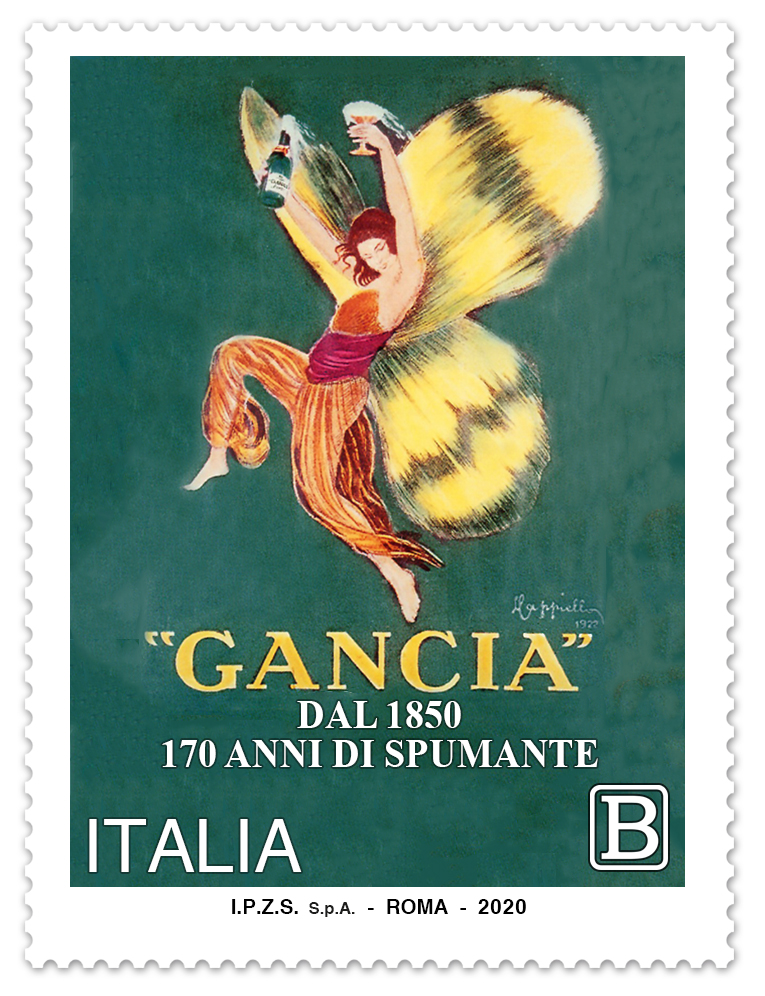
If you are interested in purchasing this stamp, you can buy it for € 1.50. By sending me a request to the email: protofilia1@gmail.com
